Home : Travel : Costa Rica : One Part
Monday, January 30, 1995
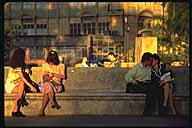 Our tour company picked us up at 6:40 and drove us downtown to the
MUSOC bus terminal. Despite the fact that this is only a 15-minute trip, they
sent along Juan Pablo, an English-speaking guide. We passed an all-metal
building on the main square downtown.
Our tour company picked us up at 6:40 and drove us downtown to the
MUSOC bus terminal. Despite the fact that this is only a 15-minute trip, they
sent along Juan Pablo, an English-speaking guide. We passed an all-metal
building on the main square downtown.
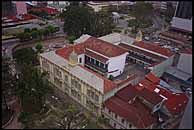 "That was constructed in England in the 19th century and was supposed to be
shipped to Punta Arenas, Chile for assembly," Juan Pablo explained. "We have a
Puntarenas on the west coast here, though and it ended up there by mistake. It
sat there for about three years before the harbor master sent a letter to the
president of Costa Rica; remember that there were no phones back then. In the
letter, he asked `What should we do with this building?' and the president
wrote back to send it to San Jose. It was one of the biggest buildings in the
capital for many years. About 35 years later, a couple of men came from Chile
to look for their building, but by then it was too late."
"That was constructed in England in the 19th century and was supposed to be
shipped to Punta Arenas, Chile for assembly," Juan Pablo explained. "We have a
Puntarenas on the west coast here, though and it ended up there by mistake. It
sat there for about three years before the harbor master sent a letter to the
president of Costa Rica; remember that there were no phones back then. In the
letter, he asked `What should we do with this building?' and the president
wrote back to send it to San Jose. It was one of the biggest buildings in the
capital for many years. About 35 years later, a couple of men came from Chile
to look for their building, but by then it was too late."
MUSOC is allegedly the finest long-distance bus company in Costa Rica and the
huge Scania bus looked promising. It had been built in Brazil and I think that
Costa Rica was its first tour of duty. My only complaint was that they'd
packed in seats for 59 passengers so legroom was not adequate for the American
physique.
Chantal and I ate a banana and a candy bar while waiting for the bus to leave.
Bobby had said that every bus was required by law to have a trash can, but I
couldn't find it. One of the three men administering the bus very kindly
offered to take the peel and wrapper off my hands. He tossed them
unceremoniously in the gutter.
The Interamerican Highway going south leaves San Jose in style. The first
section is four lanes and divided. The Highway quickly rises up into the
mountains, however, and deteriorates into a two-lane undivided potholed mess.
Our bus was constantly passing underpowered overloaded trucks spewing diesel
soot. A solid yellow line makes passing illegal most of the way, but that
doesn't stop anyone, not even when clouds are sitting right on the road.
We were climbing up to one of the highest passes in Costa Rica, over 10,000
feet above sea level. The road twisted and wound back on itself. Chantal was
listless with carsickness but perked up when our bus nearly flattened an
oncoming motorcyclist while trying to pass a truck. None of the Costa Ricans
on the bus seemed surprised by the incident. In fact, despite the presence of
young children, the whole ride was as quiet and reserved as a church service.
After we'd driven 2.5 hours south, we stopped in San Isidro de El General, a
prosperous agricultural town of perhaps 55,000 inhabitants. Jessica, a
cheerful Canadian/Costa Rican picked us up at the terminal for the ride down to
Hacienda Barú, a farm/nature reserve on the Pacific coast in Dominical.
As we drove down the mountain, the weather went from cool and comfortable to
warm and sticky. I asked Jessica if she didn't prefer her family home in
British Columbia to the tropics.
"I have mixed feelings," she replied. "We live in a small town in central
British Columbia and it is difficult for anyone with dark skin to fit in. My
mother is a very dark Latin woman and she is constantly being taken for Native
American or Indian, neither of which is a good thing to be in Canada. My
brothers are blond with green eyes, though. They went to high school in
Canada, fit in well, and love it up there. I feel more at home here in Costa
Rica. These are my people."
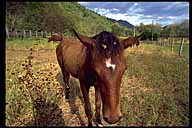 We were graciously welcomed at Hacienda Barú farm
where we chatted with
Diane and Jack Ewing, Coloradans who came down here 25 years ago to manage a
cattle ranch.
We were graciously welcomed at Hacienda Barú farm
where we chatted with
Diane and Jack Ewing, Coloradans who came down here 25 years ago to manage a
cattle ranch.
"This ranch, which is 330 hectares [800 acres], was bought by a group of
American investors back in 1970 and they asked me to fly down here with a bunch
of cattle to look after it," Jack said. "We came down in a DC-6 cargo plane
and almost didn't make it off the ground from Miami."
"The cows were so heavy that they had to take the air conditioner out," Diane
added, "so we were crammed in the front behind the navigator and the heat was
stifling. Water was dripping down from the ceiling and condensing on the
windshield. The pilots had to wipe the windshield off with toilet paper just
so they could see out."
How were things different back then?
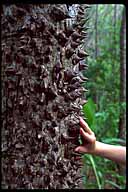 "First of all, there was no electricity," Jack said. "We didn't get that until
about 1978. I don't like generators so we just made do with a propane
refrigerator and lanterns. There is still no telephone service down here,
except for the two public phones in Dominical. The big change is yet to come.
That road in front of the house is going to be the new Interamerican Highway.
All the bridges and most of the grading has been done. Now they just need to
pave it."
"First of all, there was no electricity," Jack said. "We didn't get that until
about 1978. I don't like generators so we just made do with a propane
refrigerator and lanterns. There is still no telephone service down here,
except for the two public phones in Dominical. The big change is yet to come.
That road in front of the house is going to be the new Interamerican Highway.
All the bridges and most of the grading has been done. Now they just need to
pave it."
When will the highway be complete?
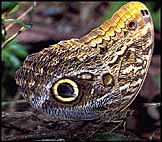 "In 1973, they said they were going to have it finished by 1974," Jack
answered. "A lot of things were different back then. Nobody had even heard of
ecotourism. When I told my partners about turning this place into a reserve,
preserving the primary forest we had and letting the pastures grow back into
secondary forest, they thought I was crazy, that you could never make any money
thinking that way. Fortunately, Steve came along in 1988 and thanks to him
we've been able to get away from the old ways of doing things."
"In 1973, they said they were going to have it finished by 1974," Jack
answered. "A lot of things were different back then. Nobody had even heard of
ecotourism. When I told my partners about turning this place into a reserve,
preserving the primary forest we had and letting the pastures grow back into
secondary forest, they thought I was crazy, that you could never make any money
thinking that way. Fortunately, Steve came along in 1988 and thanks to him
we've been able to get away from the old ways of doing things."
How difficult was it adapting to life here, especially with young children to
raise?
"After four months here," Diane said, "I was more than ready to go back to the
States, but I gradually got used to it and came to prefer it down here. Now it
is the U.S. that seems foreign. I go back for a month and a half every year.
It takes me a week just listening to people talking about new products and
services and terms before I'm willing to speak myself; I don't want anyone to
think I'm out of it. On the other hand, by the time I'm ready to come home,
the part of American life that strikes me as strangest is the materialism and
the waste. Last trip, I came back with a huge duffel bag full of plastic
containers that my parents were going to throw out."
Hacienda Barú has a canopy platform that is basically the same idea as
the Corcovado platform, but a comparison reveals the deep differences between
American (actually Berkeleyan) and Costa Rican thinking.
Corcovado costs $70; Barú costs $30.
In Corcovado, the platform is rigid fiberglass-graphite-epoxy; in Barú,
the platform is flexible wood.
The Corcovado platform is rigidly fixed to the tree with numerous steel cables
and hardware that would look at home on the George Washington Bridge; the
Barú platform hangs from about nine ropes looped around branches in the
tree.
In Corcovado, you wear two independent harnesses that are attached to
independent ropes; in Barú, you wear one tree surgeon's harness that is
attached to two independent ropes.
In Corcovado, you sign a liability waiver, get a thirty-minute orientation
talk, and are cautioned to wash your hands if you have applied insect repellent
because it might attack the nylon ropes; in Barú you don't get a lot of
elaborate lectures and forms.
In Corcovado, you are lowered; in Barú you rappel down after a brief
tutorial. [Both platforms have belays in the hands of a professional.]
In Corcovado, they "like to keep the exact height of the platform a mystery,
but it is around 120 feet"; In Barú, it is "106 feet high."
In Corcovado, you are asked to experience the transcendental mystery of the
rainforest; in Barú, Jack tells you that "this is tropical wet forest,
according to Holdridge, the biologist who divided climates into 23 categories.
It's just a fancy word for jungle."
Both will get you to the top, both are very unlikely to kill you, but Corcovado
caters better to the paranoid.
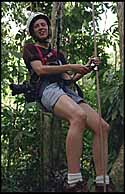 On the ropes.
On the ropes.
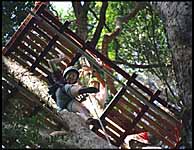 Chantal, almost up.
Chantal, almost up.
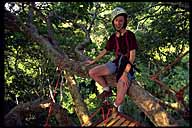
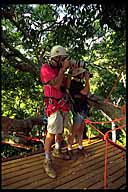
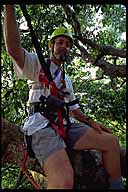 Jack Ewing, our host, on the platform.
Jack Ewing, our host, on the platform.
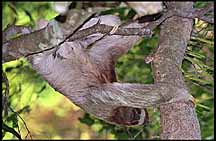 Cicadas make a deafening racket here from December through March and we could
barely hear ourselves think during the short easy walk through the forest.
Still, the canopy seemed peaceful and exciting at the same time. We looked
around at a few hawks before noticing that there was a three-toed sloth about
six feet from our noses, quietly making his way through the very tree we were
in.
Cicadas make a deafening racket here from December through March and we could
barely hear ourselves think during the short easy walk through the forest.
Still, the canopy seemed peaceful and exciting at the same time. We looked
around at a few hawks before noticing that there was a three-toed sloth about
six feet from our noses, quietly making his way through the very tree we were
in.
We were so engrossed in watching the sloth that it was quite some time before
we noticed that a large group of Chestnut-Mandibled Toucans had arrived in our
tree to feed off the fruit of the Strangler Fig that was attached to the trunk.
This was by far the closest I'd seen toucans and their appearance was
magnificent even if the bird can be kind of nasty (eating the nestlings of
other birds, for example).
I stood in a cold shower for a long time before emerging for dinner at
Manigordo ("Ocelot" in Spanish), run by Roberto, a 24-year-old Milanese who
struggles to serve first-class Northern Italian cuisine here in the jungle.
Tuesday, January 31, 1995
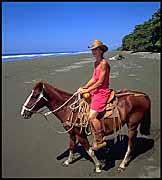 Diane Ewing has probably the nicest, best-cared for horses in Costa
Rica. Even the saddles were exquisitely crafted and padded, the best I'd ever
been on. My horse was Butterfly and he responded to even the slightest
adjustment of his Western-style reins.
Diane Ewing has probably the nicest, best-cared for horses in Costa
Rica. Even the saddles were exquisitely crafted and padded, the best I'd ever
been on. My horse was Butterfly and he responded to even the slightest
adjustment of his Western-style reins.
After a quick tour round Barú's remaining pastures, we went into the
mangrove.
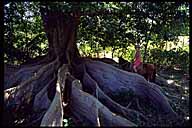 "This is called the cradle of the ocean," Diane said. "A lot of the most
important species of ocean fish come in here for protection when they are young
and spend two or three years. Red Snapper, for example. Jack was the first
person in Costa Rica to ask the government to declare his mangrove a protected
area so that nobody could ever destroy it. They didn't know how to do it at
first because they didn't have the right paperwork. People asked for
permission to destroy mangroves every week and the permission was always
granted, but there had never been an application to protect the mangrove."
"This is called the cradle of the ocean," Diane said. "A lot of the most
important species of ocean fish come in here for protection when they are young
and spend two or three years. Red Snapper, for example. Jack was the first
person in Costa Rica to ask the government to declare his mangrove a protected
area so that nobody could ever destroy it. They didn't know how to do it at
first because they didn't have the right paperwork. People asked for
permission to destroy mangroves every week and the permission was always
granted, but there had never been an application to protect the mangrove."
 We passed underneath a fig tree in which a large troupe of white-faced monkeys
was feeding, then out through the mangrove onto the beach where huge waves
pounded the sand. After riding up to the mouth of the Rio Barú, we rode
back to the Hacienda and then drove to Dominical for lunch.
We passed underneath a fig tree in which a large troupe of white-faced monkeys
was feeding, then out through the mangrove onto the beach where huge waves
pounded the sand. After riding up to the mouth of the Rio Barú, we rode
back to the Hacienda and then drove to Dominical for lunch.
"This used to be a town of about 60 year-round residents," Jack said. "That
was when it was a two and a half hour drive to San Isidro on a dirt road. Now
it has been discovered by surfers and all kinds of people are coming here for
the dry season."
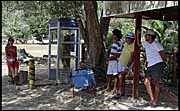 We stopped at a Mexican-American restaurant for lunch. Mike, a tanned
Californian, came over to take our orders.
We stopped at a Mexican-American restaurant for lunch. Mike, a tanned
Californian, came over to take our orders.
"This place used to be owned by Mamo and Maritzia, a local couple. They sold
out and moved out to the mountains near Cartago," Jack explained.
Did they get tired of the heat?
"They needed to get out of debt," Diane answered.
"These people could spend more money than anyone you ever saw," Jack
elaborated. "They had a big family and tried to support all of them with
incredible luxuries off this one restaurant in this tiny little town. Of
course, all the actual work was done by employees, but they had a huge
television, a European education for one of their children, and all sorts of
things we would never have considered.
"They took almost every gringo in town for at least a few hundred dollars with
terribly sad stories of distress. It got so that when a new gringo moved down
here, he'd be warned by the existing ones about Mamo. That's when they had to
sell the place."
How much could they really spend in a town like Dominical?
"They were negotiating with a buyer for the restaurant at 10 a.m. and took
$2000 in earnest money from him. They drove up to San Isidro and spent it all
plus ordered $4000 more stuff and were back by 2 p.m. to finalize the deal.
When they sat down with the buyer again, they changed all the terms of the
contract so that he would back out. He asked for his earnest money back and
they said `we already spent it.' Of course, it was really his fault because he
was crazy to give them any money without making them sign a contract.
Eventually they sold it to a gringo named Jim and moved to a town up in the
mountains near Cartago. Jim named the place Jungle Jim's and then Mike bought
it and renamed it San Clemente Cafe, but everyone calls it Jungle Mike's."
 The food was excellent, but shockingly spicy by Costa Rican standards.
The food was excellent, but shockingly spicy by Costa Rican standards.
"When we moved here, we were really disappointed in the food; it was so bland,"
Diane said. "The Mexican food we get in the States is Northern Mexican. It
turns out that the southern Mexicans have a bland cuisine and that's pretty
much what you get through the rest of Central America."
Disappointed at first? How had their feelings changed since then?
"They haven't; we're still disappointed."
All this talk about contracts reminded me to ask Jack whether he'd figured out
Costa Rica's legal system. I knew that it was a Roman Civil Code-based
country, but didn't understand what that meant in practice.
"Well, for one thing," Jack said. "The laws about slander and libel are much
tougher than in the U.S. If you say that somebody stole and you can't prove
what and where exactly, you are in deep trouble."
Does that stifle the press when it comes to covering politics?
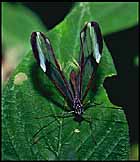 "They walk a fine line. They'll say that a politician is a crook but not a
thief. Or they'll insinuate or say that someone else said that..."
"They walk a fine line. They'll say that a politician is a crook but not a
thief. Or they'll insinuate or say that someone else said that..."
What about liability? What if the roof of the restaurant fell on us right now
and broke some bones?
"Very likely there would be nobody to sue, unless the people didn't get permits
and were grossly negligent. A case in San Jose that got a lot of press
concerned two hospital patients who were killed by anesthesia. Oxygen is
supposed to go in green bottles and nitrogen in blue. But the company that
fills the bottles ran out of blue bottles one day so they filled a bunch of
green bottles with nitrogen and marked them with an N in grease pencil. The
workers who load trucks didn't know this meant Nitrogen, though, so they sent
them to the hospital which used them as oxygen and two people died."
Was there a lawsuit?
"Of course. The relatives of the patients sued the hospital, the
anesthesiologist, the guy who carried the cylinder from the hospital storeroom,
everyone they could think of. But under the Civil Law, there was apparently no
way they could sue the gas company, which it was obvious to everyone was the
negligent party. In the end, nobody got a dime in compensation from that
suit."
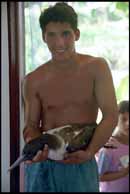 What about standard contract litigation? Did it take ten years like in Italy,
another Civil Law country?
What about standard contract litigation? Did it take ten years like in Italy,
another Civil Law country?
"Ten years would be a minimum for a simple lawsuit here. It all depends on how
long the parties want to keep it alive with appeals. A contract in Costa Rica
is basically worthless. I don't really care whether I can get a written
contract from someone; it isn't any better than his word. If I trust a man,
I'll just take his word. If I don't, I won't deal with him at all."
The interior of the restaurant and the exterior of Mike's face were decorated
with testimonies to the power of the surf here. Broken surfboards hung from
the ceiling, marked with the date and the owner's signature; Mike had a huge
scar on his face.
"That was a 10 foot wave," he said, " which is pretty common around here, but
the surf gets much bigger sometimes."
Was it really worth moving down from Orange County for better waves?
"Definitely. The surf is much bigger and more consistent here. Plus the water
is warm."
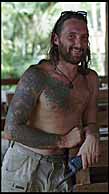 Dieter, another guy who came here to surf, strolled up and displayed the
tattoos that covered his bare arm and chest.
Dieter, another guy who came here to surf, strolled up and displayed the
tattoos that covered his bare arm and chest.
"Look at you," Diane said, "carrying a radio."
"I have to," Dieter explained. "I'm the only one covering the dive shop
business right now."
Dieter was a Dutchman who had worked on North Sea oil rigs.
"I spent my two weeks off in the South of France, up in the mountains, but you
are still spending two weeks on and eventually that adds up to half your
life."
The pay is great though, isn't it?
"Doesn't matter what the pay is. I was nearly killed three times, twice in the
same week. That's when I decided to quit and come here to relax."
Like so many expatriates who came to Costa Rica to kick back, Dieter had
discovered that a little bit of First World capital, knowledge and drive went a
long way to making a successful business in Costa Rica. Unfortunately, most of
these businesses became so successful that the would-be retiree was soon
working more hours/week than ever.
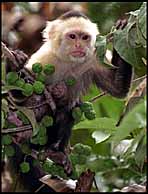
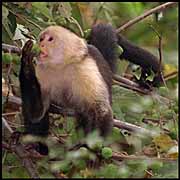 Photographing these white-faced monkeys wasn't easy. Even with a
tripod and ISO 400 film, it was too dark under the tree near sunset to
get decent results. A big Canon flash saved the day to some extent.
Although the monkeys seemed quite close, a 350mm lens wasn't powerful
enough to fill the frame. I had to crop these quite a bit in
PhotoShop.
Photographing these white-faced monkeys wasn't easy. Even with a
tripod and ISO 400 film, it was too dark under the tree near sunset to
get decent results. A big Canon flash saved the day to some extent.
Although the monkeys seemed quite close, a 350mm lens wasn't powerful
enough to fill the frame. I had to crop these quite a bit in
PhotoShop.

 A pair of wood storks had chosen the area near the hacienda's bird
blind for their home. These are magnificent huge birds that fly fast.
I used Canon AI Servo continuous autofocus and the five sensors in my
EOS-5 to get a whole pile of 100% sharp photos of the birds in flight.
Again, a 350 was a little short. I should have had the Canon 600/4
($8500 and comes in its own suitcase).
A pair of wood storks had chosen the area near the hacienda's bird
blind for their home. These are magnificent huge birds that fly fast.
I used Canon AI Servo continuous autofocus and the five sensors in my
EOS-5 to get a whole pile of 100% sharp photos of the birds in flight.
Again, a 350 was a little short. I should have had the Canon 600/4
($8500 and comes in its own suitcase).
After two cold showers and an afternoon forest/beach hike, we sat down for a
barbecue dinner with Jack and Diane at the house, which was filling up with
frogs, lizards, and praying mantises. Jack and Diane make no attempt to keep
the jungle out and the windows are mostly unscreened. As a New Englander
accustomed to the explosion of mosquitoes in the summer, it was amazing to
think that one could essentially live in the middle of the jungle and not get
bitten. However, there are apparently enough insect-predators in the Costa
Rican rainforest that mosquitoes aren't normally a problem.
When the food was ready, we moved to a thatch roofed-pavilion containing three
stone picnic tables.
"One day about five months ago a Boa Constrictor tumbled down off the roof
wrapped around a `possum," Jack pointed. "He was so stunned that he left the
possum on the ground. For the next four or five days, he moved in here among
the rafters. This is where we bring guests after hikes so he made a great
conversation piece. One day I noticed he was gone. Then the next day I found
him in a corner of the house with a big lump in the middle. I went into the
bathroom and all of the cats were in there with me."
Jack paused.
"That seemed kind of odd. When I came out, I did a head count of the cats and
it turned out that two of the kittens were missing."
How big was the Boa?
"About ten feet long."
We asked CJ, who'd been our guide, to compare his time in Wisconsin with life
in Costa Rica. Somehow he started talking about the fighting cocks he'd seen
being trained.
"They put sharp steel pins on their feet and then set them at each other. I
saw two go around each other for awhile before one of them finally managed to
get the other's head in between his claws. The other cock was killed
instantly, with two pins in his eyes."
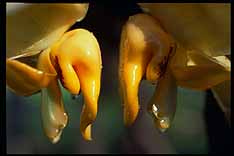 "That reminds me of a Costa Rican joke," Jack said. "I heard it in Spanish but
it translates pretty well into English.
"That reminds me of a Costa Rican joke," Jack said. "I heard it in Spanish but
it translates pretty well into English.
"The Americans and Russians at the height of the arms race realized that if
they continued in the usual manner they were going to blow up the whole world.
One day they sat down and decided to settle the whole dispute with one dog
fight. They'd have five years to breed the best fighting dog in the world and
whichever side's dog won would be entitled to dominate the world. The losing
side would have to lay down its arms.
"The Russians found the biggest meanest Doberman and Rottweiler bitches in the
world and bred them with the biggest meanest Siberian wolves. They selected
only the biggest and strongest puppy from each litter, killed his siblings, and
gave him all the milk. The used steroids and trainers and after five years
came up with the biggest meanest dog the world had ever seen. Its cage needed
steel bars that were five inches thick and nobody could get near it.
"When the day came for the fight, the Americans showed up with a strange
animal. It was a nine foot long Dachshund. Everyone felt sorry for the
Americans because they knew there was no way that this dog could possibly last
ten seconds with the Russian dog.
"When the cages were opened up, the Dachshund came out and wrapped itself
around the outside of the ring. It had the Russian dog almost completely
surrounded. When the Russian dog leaned over to bite the Dachshund's neck, the
Dachshund leaned up and consumed the Russian dog in one bite. There was
nothing left at all of the Russian dog.
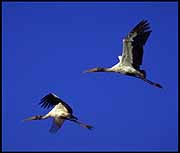 "The Russians came up to the Americans shaking their heads in disbelief. `We
don't understand how this could have happened. We had our best people working
for five years with the meanest Doberman and Rottweiler bitches in the world
and the biggest meanest Siberian wolves.'
"The Russians came up to the Americans shaking their heads in disbelief. `We
don't understand how this could have happened. We had our best people working
for five years with the meanest Doberman and Rottweiler bitches in the world
and the biggest meanest Siberian wolves.'
"`That's nothing,' an American replied. `We had our best plastic surgeons
working for five years trying to make an alligator look like a Dachshund.'"
I told Jack that I'd seen two kinds of expatriates living in Costa Rica: those
whose personalities were simply too large to fit into the bland United States
anymore and those who wanted to relax. Had he formed any similar theories?
"Most expats go through phases. In the first phase, they put all their trust
in one key employee. This is a Tico who understands their hand signals and the
way they pronounce the few words of Spanish they know. This is the only person
they can communicate with so they trust him with big decisions and a lot of
money. Unfortunately, this guy has never made big decisions or handled this
kind of money so eventually he takes advantage of the expat. This leads the
expat into a phase where he thinks everyone is out to get him.
"After two years, the expat has learned enough Spanish and met enough Ticos
that he grows out of the phase and learns to trust some people or he sells
everything and moves back to the States."
We asked Jack about the animals living at Hacienda Barú.
"We've got a list with over 300 bird species, more than 50 mammals including a
puma that comes around every few months, but I'm sure the number of insect
species is greater than the rest put together. E.O. Wilson said he found one
tree in the rainforest with 52 species of ants living in it. I was up in a
tree last Saturday and there were four different species of ants crawling on my
legs. Three of those were biting me."
What about army ants?
"They come marching through a few times a year," Diane replied. "They clean
out everything in the house. They really move fast."
How do they kill other insects?
"With sheer numbers," Jack said. "If one of them gets on the back of a roach
or a beetle, it is all over. He'll sting the larger insect and then hundreds
of other army ants will come over and sting the roach until it dies. They
could even kill a dog if it were tied up. One of the strangest things I ever
saw was up in the primary forest here. A column of army ants had marched
across a leaf-cutter ant trail. The leaf cutter ants had made a 90-degree turn
and marched parallel to the army ants for at least 200 yards until they came to
a branch, at which point the leaf-cutters went over and the army ants went
under."
As we were proceeding back to the house along a dark stone path, I stepped
gingerly and asked Jack what was the closest to the house he'd seen a
fer-de-lance.
"Oh, maybe two or three meters," he replied. "One of our workers was walking
out of the house and stepped right on one lying in the path. I haven't seen
one in a long time, though. There's a nine-foot-long gray snake that lives
here now and it feeds exclusively on fer-de-lances."
Wednesday, February 1, 1995
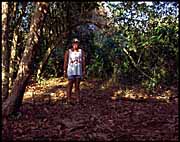 CJ took us out to the bird blind in the mangrove around 6:45, but the
wood storks were already out of their tree and the water had receded to a point
50 yards or so from the blind. The most interesting thing we saw was a huge
clearing that looked artificial. On the ground were mounds of earth and
thousands of leaf-cutter ants coming and going on broad trails.
CJ took us out to the bird blind in the mangrove around 6:45, but the
wood storks were already out of their tree and the water had receded to a point
50 yards or so from the blind. The most interesting thing we saw was a huge
clearing that looked artificial. On the ground were mounds of earth and
thousands of leaf-cutter ants coming and going on broad trails.
"This whole clearing was made by the ants," CJ explained. "They bring the
leaves down underground and cut them up but don't eat them. What they live on
is a fungus that they cultivate on the leaves. The reason the trails are so
clean is that they don't want the fungus to get contaminated with other
bacteria."
After a shower, we packed up and rode up the mountain to San Isidro with CJ to
catch a MUSOC bus, this time a nice Mercedes, back to San Jose. By now we were
getting adjusted to the pace and pulse of the city and it didn't frighten us as
much. We even stopped for a nice vegetarian meal at the Vishnu restaurant
before catching a taxi back to the Milvia, which seemed more pleasant each time
we returned.
A few photos from downtown San Jose....
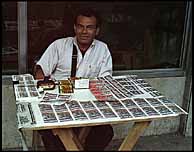
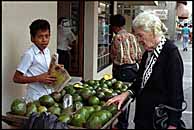

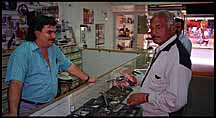
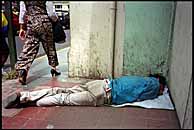
Thursday, February 2, 1995
We showed up at the contemporary art museum around 10:10. The guard
explained that the museum opened at 10 and therefore should be open shortly.
We sat with Chris, a Jehovah's Witness from Arkansas, and his girlfriend, a
black woman from the countryside.
"I came down here because there was a need for Witnesses," Chris explained.
"I'm in a little valley over the mountains toward San Isidro. I thought I
wouldn't stay too long, but I love it there."
What kind of a need was there exactly?
"Our mission is to visit every person in the world at least once, preferably
several times," Chris said. "There were about 30 Witnesses in my town before I
came here; now there are about 36."
Why did they need him if they had 30 people already?
"Most of the people in our church work and have families," Chris answered.
"They can't afford to donate more than 10 hours/month. I donate 60 hours/month
and teach English to hold body and soul together the rest of the time. It
doesn't cost much where I live. You can rent a whole house for $50/month or
just a room for $20."
His girlfriend shivered and pulled her jacket tighter in the 72 degree
weather.
"She thinks it's cold here," said Chris. "Can you believe it?"
We chatted until 10:30 or so but the art museum still hadn't opened so we
proceeded to the Jade Museum, on the 11th floor of a high-rise belonging to the
National Insurance Institute. Many of the pieces from 200 B.C. through 500
A.D. were very finely carved. Almost all had been discovered in Costa Rica.
Some kind of stylistic change or cultural decline made the later pieces look
cruder and then the artform died with the Indians shortly after the arrival of
Columbus.
After a nice ice cream downtown, we headed off to the airport with Alejandro,
the
guide who'd picked us up two and a half weeks
before. We passed the people watching planes by the road.
"It's crazy. I've seen the same families here every Sunday, all day," Alex
said. "I'm not sure why they are so thrilled. I'm kind of sick of the airport
and planes myself."
Paying our $6 departure tax and getting security to hand inspect my Macintosh
and entire camera bag (which they did thoroughly) was no problem. The flight
to Miami was uneventful except for a staggeringly beautiful view of Miami Beach
and the city from the plane. The light and the clean unscratched window by my
seat were perfect; all I lacked was a camera in hand.
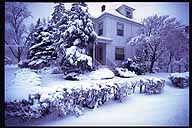
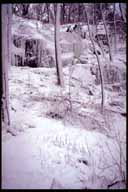 As we descended into Boston, the pilot gave us the weather forecast: "20
degrees tonight, cold tomorrow, blizzard on Saturday with snow accumulations of
a foot or more."
As we descended into Boston, the pilot gave us the weather forecast: "20
degrees tonight, cold tomorrow, blizzard on Saturday with snow accumulations of
a foot or more."
Check the map of Costa Rica for orientation (80K)
 Up to the Cover Page
Up to the Cover Page
philg@mit.edu
Related Links
Add a comment | Add a link
 Our tour company picked us up at 6:40 and drove us downtown to the
MUSOC bus terminal. Despite the fact that this is only a 15-minute trip, they
sent along Juan Pablo, an English-speaking guide. We passed an all-metal
building on the main square downtown.
Our tour company picked us up at 6:40 and drove us downtown to the
MUSOC bus terminal. Despite the fact that this is only a 15-minute trip, they
sent along Juan Pablo, an English-speaking guide. We passed an all-metal
building on the main square downtown.



 On the ropes.
On the ropes.




 Cicadas make a deafening racket here from December through March and we could
barely hear ourselves think during the short easy walk through the forest.
Still, the canopy seemed peaceful and exciting at the same time. We looked
around at a few hawks before noticing that there was a three-toed sloth about
six feet from our noses, quietly making his way through the very tree we were
in.
Cicadas make a deafening racket here from December through March and we could
barely hear ourselves think during the short easy walk through the forest.
Still, the canopy seemed peaceful and exciting at the same time. We looked
around at a few hawks before noticing that there was a three-toed sloth about
six feet from our noses, quietly making his way through the very tree we were
in.








 Photographing these white-faced monkeys wasn't easy. Even with a
tripod and ISO 400 film, it was too dark under the tree near sunset to
get decent results. A big Canon flash saved the day to some extent.
Although the monkeys seemed quite close, a 350mm lens wasn't powerful
enough to fill the frame. I had to crop these quite a bit in
PhotoShop.
Photographing these white-faced monkeys wasn't easy. Even with a
tripod and ISO 400 film, it was too dark under the tree near sunset to
get decent results. A big Canon flash saved the day to some extent.
Although the monkeys seemed quite close, a 350mm lens wasn't powerful
enough to fill the frame. I had to crop these quite a bit in
PhotoShop.

 A pair of wood storks had chosen the area near the hacienda's bird
blind for their home. These are magnificent huge birds that fly fast.
I used Canon AI Servo continuous autofocus and the five sensors in my
EOS-5 to get a whole pile of 100% sharp photos of the birds in flight.
Again, a 350 was a little short. I should have had the Canon 600/4
($8500 and comes in its own suitcase).
A pair of wood storks had chosen the area near the hacienda's bird
blind for their home. These are magnificent huge birds that fly fast.
I used Canon AI Servo continuous autofocus and the five sensors in my
EOS-5 to get a whole pile of 100% sharp photos of the birds in flight.
Again, a 350 was a little short. I should have had the Canon 600/4
($8500 and comes in its own suitcase).









